We provide an Advanced Predictive Maintenance Program with State-of-the-Art Equipment
Industrial and/or automotive equipment have increasingly demanding requirements, making it necessary to control their operating conditions.
Oil/lubricant is the agent that can give us precise information about the performance of an engine, transfer case, reducer, hydraulic system, among other components.
Our laboratory has personnel and state-of-the-art technology to interpret such information.
Sample collection
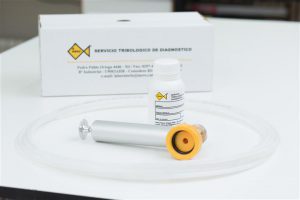 Sampling is the most important part of the analysis, as the accuracy and reliability of the test results depend on it.
Sampling is the most important part of the analysis, as the accuracy and reliability of the test results depend on it.
We have qualified personnel for the sampling of lubricants in various equipment or, if desired, we can provide them with the sampling procedure and materials (bottles, labels, vacuum pump, and translucent tube for the pump).
Sample Entry and Analysis
Once the sample is received in our laboratory, it is necessary to perform different tests depending on the type of lubricant and/or equipment being tested.
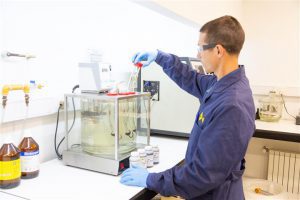 Kinematic viscosity ASTM D445
Kinematic viscosity ASTM D445
This is the most important physical property of lubricants, as it indicates their ability to flow.
It is measured at 40°C and 100°C in mm2/s or cSt (centistokes).
The critical viscosity value will be determined by an upper and lower percentage, based on the nominal ISO grade or the viscosity of a new oil sample, considering that a value outside this range will be considered condemnatory.
RDE-OES Emission Spectrometry ASTM D6595
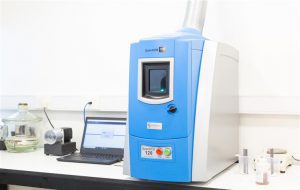 This elemental analysis spectrometer provides concentration in ppm (parts per million) of 24 elements from the periodic table, classified as:
This elemental analysis spectrometer provides concentration in ppm (parts per million) of 24 elements from the periodic table, classified as:
*Wear metals
*Additives
*Contaminants Ag-Al-B-Ba-Ca-Cd-Cr-Cu-Fe-K-Li-Mg-Mn-Mo-Na-Ni-P-Pb-Sb-Si-Sn-Ti-V-Zn
The critical concentration values of elements in the emission spectrometry will be determined by an established maximum based on previous experience and technical specifications from the manufacturer.
Infrared Spectrometry FT-IR ASTM 2412
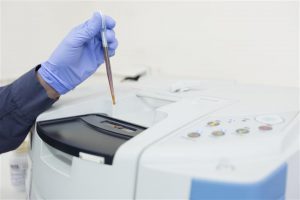 Infrared analysis is a powerful tool that provides comprehensive information on the state of the lubricant and the presence of contaminants.
Infrared analysis is a powerful tool that provides comprehensive information on the state of the lubricant and the presence of contaminants.
Soot: It is a partial measure of the level of burned fuel particles in the oil.
Oxidation: It indicates the degree of oil oxidation. Prolonged oxidation can lead to corrosion and increased viscosity.
Nitration: It results from the reaction of the oil with nitrogen oxides during the combustion process.
Sulfation: It measures the rate at which sulfuric acid compounds enter the oil.
Dilution: It provides the percentage of diesel fuel contamination in the sample.
Water and glycol: The presence of water and glycol in the oil indicates leaks in the cooling system.
ZnDTP: It indicates the depletion of anti-wear additives.
The critical value of each item in the infrared spectrometry will be determined by a maximum, depending on the type of oil being tested.
ISO 4406 Cleanliness Code
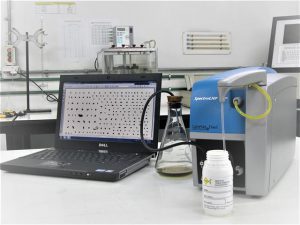 The ISO 4406 cleanliness code is used to determine the cleanliness level of a system. It is an excellent tool for setting alarms and targets to achieve. According to this standard, a code (number) is assigned to the quantity of particles in 1 mL of the sample, counted at three different size levels: greater than or equal to 4, 6, and 14 microns (R4/R6/R14).
The ISO 4406 cleanliness code is used to determine the cleanliness level of a system. It is an excellent tool for setting alarms and targets to achieve. According to this standard, a code (number) is assigned to the quantity of particles in 1 mL of the sample, counted at three different size levels: greater than or equal to 4, 6, and 14 microns (R4/R6/R14).
The limit level of this code is determined by a maximum established based on previous experience and technical specifications. However, it is essential to have the cleanliness target that each customer requires for their system.
Copper Strip Corrosion ASTM D130
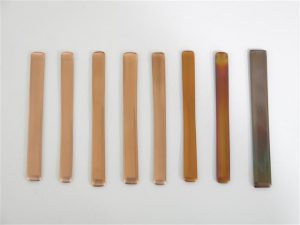 This test determines the degree of corrosion caused by a lubricant on a polished copper strip. The interpretation is based on the color change of the strip, according to one of the classifications in the standard. It is considered acceptable in classifications 1a, 1b, and 2a, and above these it is not acceptable.
This test determines the degree of corrosion caused by a lubricant on a polished copper strip. The interpretation is based on the color change of the strip, according to one of the classifications in the standard. It is considered acceptable in classifications 1a, 1b, and 2a, and above these it is not acceptable.
Total Acid Number or TAN ASTM D974
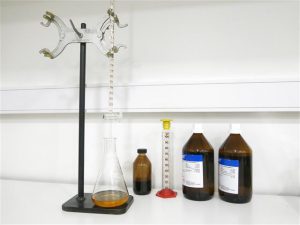 This test is an indicator of the acidity levels in the oil, often accompanied by increases in viscosity, oxidation, nitrification, and sulfation.
This test is an indicator of the acidity levels in the oil, often accompanied by increases in viscosity, oxidation, nitrification, and sulfation.
TAN tests are often used to establish optimal oil change intervals for many types of industrial oils, particularly those used in natural gas engines.
These acids are extremely corrosive to the interior parts of the engine and can cause catastrophic failures if proactive measures are not taken in time.
Microscopy
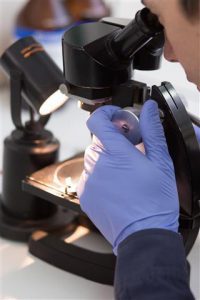 A portion of lubricant is filtered onto a 0.8-micron pore size membrane, and a qualitative description is made under a microscope of the retained solids, identifying them into the following types:
A portion of lubricant is filtered onto a 0.8-micron pore size membrane, and a qualitative description is made under a microscope of the retained solids, identifying them into the following types:
*Metallic particles
*Contaminant particles
*Sludges and varnishes *Others
This test helps us complement the results of the emission spectroscopy since it allows us to observe the larger particles that the spectrometer is limited to detect.
Water content by crackle
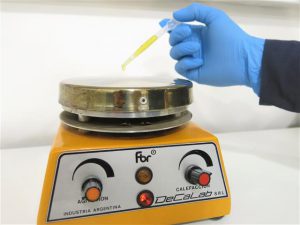 The Crackle Test is an evaluation of the pass/fail type, where the presence of water is identified by a hissing, bubbling or crackling sound when two drops of oil are placed on a hot plate at approximately 180°C.
The Crackle Test is an evaluation of the pass/fail type, where the presence of water is identified by a hissing, bubbling or crackling sound when two drops of oil are placed on a hot plate at approximately 180°C.
Other tests.
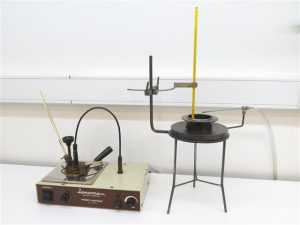 At the customer’s request, we can perform other complementary tests.
At the customer’s request, we can perform other complementary tests.
In lubricant samples:
*Flash Point (Open Cup) ASTM D92
In diesel fuel samples:
*Flash Point (Closed Cup) ASTM D93
*Density ASTM D1298
*Determination of Water by Distillation (Trap Method) ASTM D95
Report, recommendations, and suggestions
We will provide you with a PDF report detailing the results of the different tests and, additionally, the trend of the last 5 analyzed samples.
The recommendations will help you make more accurate maintenance decisions, and you will obtain the following benefits:
- Identification and elimination of causes before failures and breakdowns occur.
- Extension of oil life.
- Control of conditions to prevent machine wear and component degradation.
- Economic savings derived from condition monitoring through early detection of problems and proper maintenance action.


